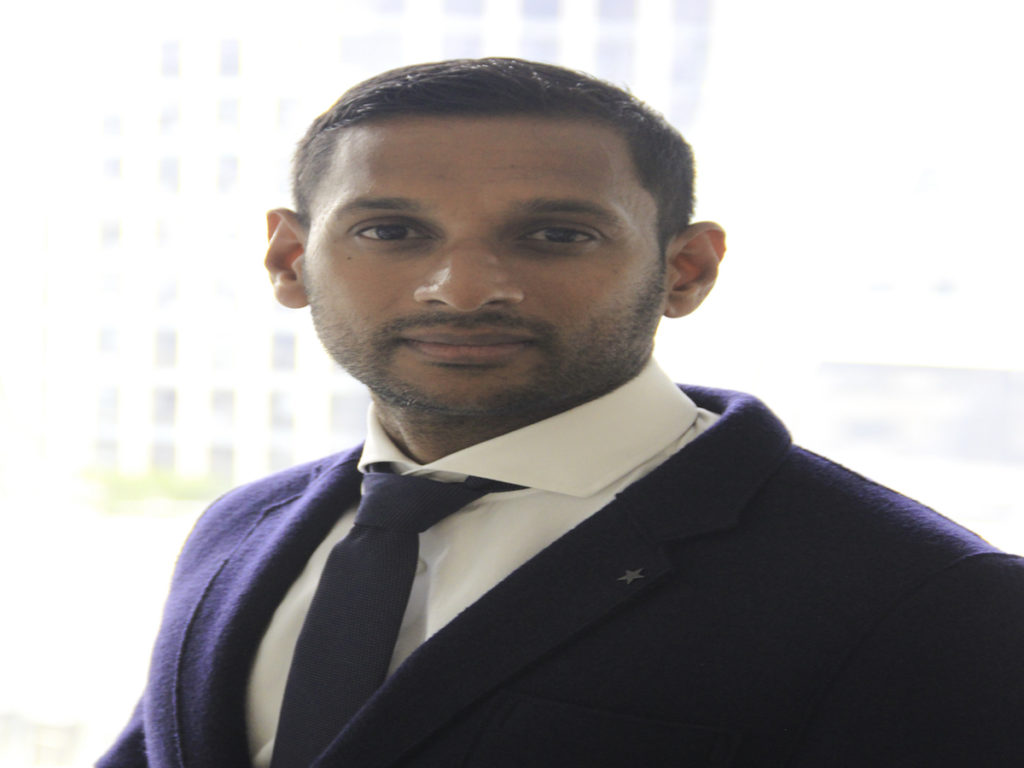Pension schemes have to invest in high-grade sovereign debt. It keeps the regulator happy and helps manage their liabilities. But the regulator also wants them to show they are protecting their members from climate risk.
So, is lending money to governments that may have coal in their energy mix a sound investment for a scheme that considers ESG when constructing a portfolio? The green gilts issued in the past few months will make it easier for sustainable-led institutional investors, but as there is not enough supply to meet demand, how are pension schemes approaching more traditional sovereign bonds?
Watch the roundtable
The panel

Chris Grant, chief investment officer, Nationwide Pension Fund
Chris has over 20 years of bank treasury experience, initially in a variety of risk management and derivatives execution roles before spending the last 10 years leading the team who manage Nationwide’s £20bn government bond portfolio. In April this year Chris was appointed to the role of CIO for the Nationwide Pension Scheme.

Nuwan Goonetilleke, head of shareholder assets Phoenix Group
Nuwan’s portfolio of responsibilities includes Sovereign, Investment Grade, Illiquid and Derivative Assets, as well as leading on development of Investment Strategy for Bulk Purchase Annuities. In his previous role as part of Swiss Re Asset Management he was responsible for overseeing the Group’s UK gilt, inflation, supranational and derivative exposures, including ReAssure’s portfolios and alpha generation within the wider Global Rates Portfolios. He has over 17 years’ experience within financial markets, with the last 12 years as a frontline portfolio manager directly responsible for structuring, pricing, risk management and execution of fixed income strategies.

Tamar Hamlyn, senior portfolio manager, Ardea Investment Management
Tamar is a senior portfolio Manager at Ardea Investment Management and has 21 years global fixed income experience and investment coverage. He currently covers government bonds, interest rate derivatives, money markets, inflation linked securities, and FX. Prior to Ardea he was a fixed income portfolio manager at Credit Suisse Asset Management in Sydney. Prior to this he was a fixed income portfolio manager at the Reserve Bank of Australia Sydney and previously an Economist and policy analyst.

Adam Matthews, Co-chair, Transition Pathway Initiative (TPI), director of ethics & engagement at the Church of England Pensions Board
Adam is the director of ethics and engagement for the Church of England Pensions Board, as well as Co-chair of the TPI and a board member of the Institutional Investors Group on Climate Change, (IIGCC). He is also the co-lead, on behalf of CA100+, for engagement with Royal Dutch Shell that led to the 2018 joint statement on climate targets agreed between Shell and institutional investors.

Gerard van der Pol, senior portfolio manager, fixed income, Unilever
Gerard’s role at Univest consists mainly of managing an internal global government portfolio and contributing to the advice to clients on LDI and rates mandates. In addition, I monitor global credit external managers in Univest’s pooled funds.

Dr Laura Ryan, head of research, Ardea Investment Management
Dr Laura Ryan is head of research at Ardea and is responsible for both the client solutions and portfolio research teams.
The client solutions team undertakes independent quantitative research to help clients solve investment problems. The portfolio research team is responsible for developing value-added recommendations to drive portfolio performance and improve client outcomes.
Laura is an internationally published academic with papers appearing in The Journal of Portfolio Management and The Journal of Forecasting, among others.

Rima Sen, credit manager research, Willis Towers Watson
Rima is an associate director within manager research, focusing on liquid strategies across traditional and alternative credit. She leads on Emerging Market Debt research within the team. Rima also leads the Inclusion & Diversity working group in manager research and sits on the investment committee for the Towers Watson Alternative Credit Fund.
The discussion
How important is ESG to institutional investors when investing in sovereign debt?
Adam Matthews: As an ethical pension fund, we consider a range of ESG criteria when assessing an asset class. Issues like climate change are important, so we need more evidence of the measures countries are taking in the assets they are bringing to market. We also need to understand how what is on offer sits within a country’s transition plan.
That is why it is important for a fund like us to work with assets owners and fund managers to determine a criteria to understand what credible looks like.
Chris Grant: This is not yet a big issue for us as we are at the beginning of our ESG journey in regards to sovereign debt. Our LDI portfolio is also quite vanilla, in that it is all gilts.
We watched the recent 10-year green gilt supply closely and may take part in the long-dated bond due in October. So, we are looking at this, but it is not something we have executed in the government space yet.
What ESG issues standout for the Nationwide Pension Scheme?
Grant: There are many. For example, in my previous life, I focused on the multi- lateral development banks and supranational agencies. They have a clear social mandate, which I expect will migrate into the government green debt space in time.
However, a potentially big limiting factor is the pipeline of green projects that governments can invest in. For example, investor demand in Germany is high, but the supply is not there. So, the market is evolving as it starts its journey.
How important is ESG to Unilever when investing in government debt?
Gerard van der Pol: We try to do more. Currently, we focus on ESG ratings and measuring the average score against the benchmark. We are also looking more at the carbon intensity of countries. Some are difficult to measure, but some managers have their own propriety system. We want to investigate this further to better assess the exposures. That is the way we are moving.
ESG ratings are supplied by external providers and are a complicated issue. There is always an element of politics involved, which I find somewhat tricky. We are trying to achieve a better score than a benchmark, which is a minimum, and measure carbon exposures, if the data is available. You could even take broader steps by being compliant with the UN Sustainable Development Goals.
Nuwan Goonetilleke: Sovereign debt is traditionally considered a risk-free asset. In other asset classes, ESG considerations came in earlier and there has been more development around corporate credit. That view is starting to change.
Whilst we do not have a specific ESG sovereign mandate, we participated in the green gilt. This could be a shift. As we work to decarbonise 50% of our investment portfolio by 2030, we are going to have to look at our sovereign bonds given their high percentage of our total assets.
Why is it important for governments to issue ESG-compliant debt?
Dr Laura Ryan: ESG risks impact everything from GDP to corruption and geopolitical outcomes, which all affect a government’s ability to repay its debts.There is lots of research showing that credit ratings are highly correlated with ESG risks, and one of the biggest drivers of yield are credit ratings. This means that ESG risks are important for driving yields, and government bond yields are important for everything.
For example, every asset class is priced o the yield curve, it sets the price of your mortgage and tells governments how much it will cost to borrow to fund their fiscal stimulus packages. So, ESG and the government bond market impacts everything.
Then there are some broader issues. Governments set the playing field for businesses and society to operate in. If they are funding coal mines and providing infrastructure for those businesses via borrowing through government bond markets, it could be argued that that is at the expense of research and development into renewable energy technology. It impacts everything from our perspective.
What is needed to encourage sovereigns to reconcile their green debt with their more traditional bonds?
Tamar Hamlyn: The difference between corporates and governments is starting to make itself present in the green bond space. From the fantastic work that has been done in corporate bonds, we now have companies that are incredibly responsive to investor expectations in terms of managing ESG risks.
What we can see from the early steps being taken is that governments are starting to go down that path. That is a fantastic development because by issuing green bonds governments are starting to show the responsiveness to market expectations that corporates are now experienced in doing. That is a positive development. The reason we think it is early steps, however, is because issuing green bonds feels like the first step on the journey.
It is convenient to momentarily forget about their large number of existing legacy bonds. It is also easy to get behind the reasons for funding a corporate if it has a particular social purpose, but the social purpose of governance is broad, touching on important functions governments need to provide. There are also functions that are less desirable in terms of their ESG risk profile.
So, issuing green bonds is the first step on the road to governments getting a better understanding of what their activities are and being responsive to the expectations of investors.
Matthews: We are at an important moment, where bonds have been brought to market specifically for green investments and projects, but we also have an increasing understanding of what is required from governments on issues like climate change.
That is challenging us to think about taking different approaches to what we might be willing to hold. South Africa, for example, generates electricity from burning coal. There is no alternative path to switch off that source. They are dependent on that despite the blackouts caused by demand on the grid.
There is an urgent demand to transition to an alternative source of energy that can equally be scaled, but, at the same time, the country is dependent on the energy system they currently have and the mines that mine the coal needed.
A significant investment is required to get South Africa’s carbon-based energy system onto a different path. I want to see bonds that can back that transition creatively in that they not only meet the government’s needs but provide what the private sector wants to support, whilst managing the transition of existing mines in a just way.
We need to support a country’s transition in a more whole market approach that recognises it is not just about providing a bond to a government. It is part of a government’s plan, how it sits in terms of its ability to deliver it and working with companies operating in that country to provide the transition finance, which may not necessarily be perfectly green in its pack- aging but is transitioning dirty assets.
Rima, what are emerging market governments investing their ESG-compliant capital in?
Rima Sen: There is increasing issuance, but there is a long way to go to catch up with the levels seen in developed markets. What is encouraging is that last year seven new countries came to the market, and there is a lot more engagement happening from the multi-laterals.
The proceeds are funding the purer green projects, but there is scope for that to become broader or to address more complex issues.
There is an additional layer of complexity in emerging markets, where a more ‘just’ transition is needed and the E does not always align with the S and the G. There are also governments whose trajectory conflicts with the green bonds they are issuing. Some in Eastern Europe, for example, are issuing green bonds but are increasing their coal capacity when there are viable alternatives.
These are things we expect our managers to look at and clients should be cognisant of. It is another issue that makes emerging markets more complex than developed markets.
When it comes to ESG, do you trust sovereigns to do with your capital what they said they would?
Goonetilleke: This is where the Green Bond Framework comes in. We also use third party fund managers.
When picking managers, this is an area where we look to work with them. It is not just about what they buy on day one, it is what is their continual process for evaluation and are they able to work with the framework and get into the ESG in that report rather than just day one.
It is relatively new in terms of its evolution, so there is time for that to bear fruit and to evaluate how well it is working in terms of reporting.
Is there much research into ESG’s impact on government bond yields?
Ryan: There has traditionally been little research on how climate change impacts government bond markets. But that is changing.
The current narrative is that climate change is not impacting government bond yields, but a research paper we have published challenges that. We found that there are a couple of transition mechanisms for climate change risks to impact government bond yields.
The first is indirectly through GDP, which can be impacted by hurricanes, cyclones and bushfires. GDP is a big driver of government bond yields, but what was not so obvious to us was that climate change transition risks were being recognised by market participants.
We thought they would consider it a long-term risk, but we found that they were being priced in and the transition risk factors we looked at were carbon dioxide emissions, renewable energy consumption and natural resource rates. Natural resource rents measures the difference between how much it costs to dig non-renewables out of the ground and how much you can sell them for.
So, if your natural resource rents are high, you probably do not have much of an incentive to move to renewables. It is the same with carbon dioxide emissions. If your economy relies on those things, it is difficult for you to transition to a clean economy.
What we found was that countries with relatively high carbon emissions would see an increase in their cost of debt. If they had higher renewable energy consumption, their cost of debt would fall and yields decrease. If their natural resource rents were higher, then their cost of debt increases.
This is a big outcome for us, particularly because we were getting that message from many investors and issuers that it was not a factor being priced in. Given that it is being priced in now, we think there is going to be an even greater premium attached to those risk factors in the future.
Matthews: The challenge we have is there is no common framework to assess if a country’s request for finance is consistent with its transition path.
Pension funds like us have made net-zero commitments and so we need to understand the risks and opportunities climate presents to each of our assets. This means measuring that to be assured we have understood the landscape and are managing our assets accordingly.
That calls for a common framework to understand the transition and its implications in this particular asset class. We use the net zero investment framework produced by the Institutional Investor of Climate Change, which frames how to approach sovereigns.
But you still require a practical tool and that is why we are working with the BT Pension Fund and investor networks to devise a methodology to understand if what a country brings to market is consistent with its transition path on climate change.
That project is getting underway and will produce a practical tool that we would look to use in our fund to navigate whether a country’s nationally determined contributions are sufficient: identifying the risks, the opportunities and dependencies within a country’s industries. There is huge potential to craft something as a collective market, to have away that we can all look at this as a common tool we can apply.
Our fund will be looking to use this to guide our interaction with managers, in how we set targets, manage risk and engage with countries because when we have a tool like that, the opportunity to engage will be different to the one we currently have, which is quite limited.
Grant: The comparability of these investments is a concern. We have seen European sovereigns’ issue in the green space and have different standards of green, even though they are labelled the same. That makes it hard to engage with the government.
This is still new for everybody, and, as yet, we have not signed up to net zero because we are still considering how we could put a credible framework in place. Furthermore, as my fund is on a de-risking path, in 10 to 15 years’ time we expect to be 90% invested in UK government debt, so we will be dependent on the government’s net-zero commitment to deliver on that ourselves.
What are investors looking for when selecting a manager to build a portfolio of ESG-compliant sovereign debt?
Goonetilleke: In addition to the normal capabilities, it is taking engagement beyond the framework and diving into those ESG bags. Data is also key and finding common points to use within the valuation framework. Managers will have their own commitments, so it is what points of commonality can we make work when selecting managers.
van der Pol: It is important that the manager is committed to sustainable investment. Their investment process should consider ESG factors. Then it depends on how much additionality the manager can provide on ESG. In government rates that is somewhat tricky as there has been more progress on the corporate side and so there is more data available.
A key element is where do you differentiate between governments and corporates.
On one hand, a country has the government or public sector, while on the other, there are the businesses and consumers. How do they interrelate? Where do we differentiate if we have to assess it on a portfolio level? Where are the borders, basically?
Commitment to ESG sustainability is important. What additional measurements or indicators can the manager provide on countries and all the individual bonds, such as quasi-government bonds.
Basically, we try to select the best manager on ESG, but on the other hand, the return aspect is important. Clients would like to achieve a good return on one hand and have full commitment to ESG on the other, but they do not always go together.
Rima, what are institutional investors looking for in a manager?
Sen: It is about differentiation. There are a lot of managers that have integrated ESG into their corporate credit process. Our clients are looking for a differentiated process for sovereigns. A corporate process cannot be applied to sovereign debt. Do you have a different analysis process? Do you have different scoring? Do you have a different way of looking at carbon metrics?
You cannot simply apply the same WACI number that you would for corporates to sovereigns, for example. So, we are looking for managers that understand that difference as well.
Something that is particularly important is that there has historically been a tendency to just focus on governance when it comes to government debt. That has previously been the biggest risk factor, but the E and the S are now being considered much bigger risks. So, making sure the manager is considering those with equal importance.
Finally, are they engaging with governments? We have heard investors and managers say they cannot engage with certain governments because they will not make an individual impact. To move from individual impact to collective impact, it is important for all investors to engage with governments of varying sizes.
We look for managers that are willing to engage, which is important because exclusion is more di cult and nuanced in government debt.
Tamar, when you sit opposite an institutional investor, how do you prove that you walk the walk and not just talk the talk?
Hamlyn: It is a challenge in the sense that we do not have the ability to exclude governments from our investment pool. Most of us are required to hold government bonds for portfolio construction or regulatory reasons, so we do not have that fundamental ability to withhold capital to encourage governments to take the steps we want them to take.
That means we fall back on engagement. Our journey through engagement has been interesting, because now that we have had a few conversations with government issuers, we realise that you have to take a different approach.
We have learned quickly that one approach that absolutely does not work, is to go to the government and say that our clients have a low tolerance for losing money on your bonds due to climate risk, so could you take steps to reduce the chance of yields going up, and, therefore, incurring lower returns.
The government’s response is to say that they have been elected on a policy platform to take certain actions and will go about our business because we have been elected by voters to do so. We appreciate your feedback, but we are not able to respond to it.
We learned early on that you need to operate within the objectives that government responds to. You need to look at the government itself and look at the entity tasked with the issuance and management of government debt. What you realise early in the process is: that entity’s primary responsibility is to maintain access to funding markets because governments like to spend money.
One of the worst things that could happen would be for governments to no longer be able to borrow to fund all the programmes that they want to do to keep the electorate happy.
When we start to phrase these engagement questions around, the investors we represent would like to do everything possible to ensure that you as the government can continue to enjoy smooth and unrestricted access to financial markets, suddenly it changes the tone and nature of the conversation from telling the government to stop doing something to laying out a path they can take to keep doing the things they are elected to do.
That inevitably involves us working with the government to outline how we can continue to have a functioning government bond market by making sure a government’s fiscal standing and strength is managed effectively.
That is going to ensure that their finances remain in good shape and they can continue to access markets. When we say to governments that if they address some of these concerns around climate risk, you might find that you widened the potential universe of investments in your debt and, therefore, your funding costs decrease.
One of the ways governments have done that is by issuing green bonds. But they could also improve their disclosures or the framework with which they provide information to investors.
We found, through our engagement efforts, that those types of conversations have been much more fruitful. One of the fascinating questions with this is how do you measure progress? How can you tell that governments are taking the steps they said they would take? In a lot of cases, you cannot measure progress, but you can look at the statements governments make and we have been satisfied with the incremental pace of change.
Engagement is totally different in the government space, and there is a different mode of operation that we are gradually learning as a fund manager how to operate within.
Gerard, how easy is it to discuss ESG targets with governments?
van der Pol: It depends on the government. Some coal producing countries have engaged with managers, given them clear objectives and allowed them to make their point about the country’s carbon emissions.
But this is a complicated issue. It is not a level playing field in that you cannot engage with all governments to the same degree.
Political ambition makes communication easier. But it is important that managers are willing to engage to get hard commitments from governments.
It is difficult because at the end of the day, it is politics, and politics can change rapidly.
Matthews: As an investor community we have sent many letters to many governments. There comes a point when you wonder how effective that is. On one level, it is a helpful signal because £xtrn signing a letter is saying this is important, but frankly, beyond some mood music, its impact is limited.
The opportunity is then to reshape the dynamic in this dialogue to have a different conversation with governments. Investors must demonstrate they understand the path a country is on, the risks it faces and how they are factoring them in. They could then collectively go into countries under pressure on issues like climate change and offer to work with them to achieve their transition objectives.
If we can get conversations in that space, I suspect the dynamic with governments will be different and could potentially achieve a higher level of ambition on the Paris climate agreement.
There will still be letters, but we will work on a more practical level with countries, which requires a mindset change. We need to be co-ordinated in the way Climate Action 100+ is with companies but engaging with countries is different. There is opportunity to come together in a co-ordinated way to signal intent, what issues are important and how we can be helpful. Those of the interventions we are looking to support and potentially engineer with others.
How easy is it for a bondholder to engage with governments as an individual?
Ryan: We do have positive outcomes. The discussions have gone from us asking for information on ESG risks to issuers wanting to talk to us about their ESG disclosures.
Explaining to issuers how important this is to the superannuation funds and the insurers we invest on behalf of makes a difference. They are unable to speak to those people directly, so it is important we set the tone by explaining to issuers just how important this is. So, engagement is definitely having positive outcomes.
Rima, are the agencies who issue debt on behalf of emerging market governments open to talking about how they will use the capital?
Sen: There is an additional opportunity, particularly when you get to the smaller or newer emerging market and frontier issuers. Even individual bondholders can make a measurable impact with governments not only open to, but actively wanting advice on what they can introduce in their policies or within a bond’s terms to attract more demand.
Tapping this green investor base is important for them. We have seen that in some of our EM strategies where there is material engagement, you can point to actual policies or projects that are being considered as a result of that. That is just from a single manager or a few managers, so in EM there is an opportunity to have a greater impact. Assuming you have the right assessments and understanding about what is required, there is a big opportunity there.
Can anyone give me some examples of how investors are partnering with governments to ensure they can continue to access the financial markets in the years to come?
Hamlyn: The conversations we have are about making sure the issues important to investors are recognised in how the market is managed and operated.I do not think that more can be done in terms of specific projects, mainly because that is well handled by the green bond issuance side and all the developments taking place there.
Setting aside green bonds, you need to take a whole of government approach to engagement. As investors we do not have the expertise to recommend specific projects or assess the viability of certain environmental schemes that the government might be considering.
The best contribution we can make is not to step in and fill those roles, because we do not have the expertise, but rather to make clear that the availability of funding is greatly improved by the steps governments are taking. Making clear that the door opens wider if governments take these steps is the biggest contribution we can make.
Goonetilleke: Pricing is incredibly key at this point. And obviously, if there is a greenium there is a trade-off. It is quite difficult as a value proposition for someone who does not have a sustainable mandate to invest in a government bond that is more expensive than the government bond that is not. As Chris highlighted, given that he has a de-risking path in his pension fund, there is going to be a natural progression there, so how do we bring all of that together to ensure that the door is as wide open as possible.
The challenge remains the value proposition and how long that will last for. If you are switching your existing stock of government bonds into the green issues, that is costing you money and not all policyholders would necessarily agree with that.
What impact will the UK’s first green gilt have on institutional investor interest in the green debt market?
Grant: It was successful, the orderbook was about £100bn for a £10bn issue which will give other green issuers confidence. The limiting factor could be a lack of supply in terms of the projects sitting in the framework. On the other side, is the premium investors are paying a saving for the government or is it paying for the framework they have had to build? I am not sure that the premium investors are paying is directly contributing to the green agenda although clearly investment in green bonds is.
Do investors have to pay a premium to hold green debt?
Hamlyn: It is a challenge. It comes down to how we interpret the lower yields we might earn on green bonds versus the higher yield on legacy bonds. There are several ways you can look at that. One, it is a lower return, so investors are paying to own green bonds.
Another interpretation is perhaps that those green ones are lower risk in that their future cash flows are linked to green projects. Perhaps there could be a realisation of ESG risk that affects legacy government bonds on issue to a larger degree than it effects the pricing of green bonds.
Some of the premiums we are talking about are quite small. It might be a five to 10 basis points difference in yield. Whilst some clients might struggle with the notion that their returns are going to be lower by 10 basis points, it does not take much for there to be a realisation of ESG risk that affects the legacy bonds by at least that amount or more.
An interesting discussion we have had with clients on this is that we are talking about five or 10 basis points; if you get it wrong there it is not going to cost you too much either way.
Everyone is comfortable and relaxed about that, but once you start looking at emerging markets, or the wider bond universe, such as government debt in China, you could be exposing yourself to a different mix of ESG risks. You might be taking governance risk as opposed to climate risk, for example.
Yet when you are making those comparisons, the yield difference is much starker. So, if you are weighing up investing in an emerging market government bond that earns 1% to 2% more than what you would get on a green gilt, you are asking yourself if only buying the green gilt and forgoing the additional yield is a decision that has been made to ensure I am not exposed to ESG risk.
To frame that question another way, is it our view that not buying those high yielding bonds will mean that the ESG risks will be realised and wipe out their additional yield advantage. So, there are some challenging questions for investors to answer.
We do not necessarily have a great framework to compare all these investments. If you are making decisions that have enormous fiduciary impacts, you need a framework to justify and validate your decisions. It is an enormous challenge that lies ahead of us.
Are you paying a premium for such debt, Adam?
Matthews: We did not buy the green gilt. The government had an advantage in coming to market when it did as it prepares to host COP26, but how do we get to a point where this is mainstream not an add on project. We need tools that enable us to understand what we can expect and to be more discerning in what we are willing to support.
Nuwan, would you be happy to pay a premium to hold this debt?
Goonetilleke: In some cases, we are. The question is: is it a premium or is the debt less risky? We have not landed on the answer. We are too early in on our journey. That is something we need to land on to continue our participation.
Adam asked when ESG-complaint debt will become mainstream. What is needed to get it to a stage where every government bond makes a positive impact on the world?
Ryan: One day we will get to a point where all bonds are ESG bonds. It will be considered along the lines of tobacco or land mines in that investors will not want those risks in their portfolio. It will be the norm.
One way of messaging that this transition needs to happen is to remind issuers and governments that ESG risks increase their cost of debt. That is important and affects everything they do.
The messaging also needs to include that there is a demand for green bonds, there is a market for them. From our perspective, green bonds are in such high demand that investors buy and hold them, which creates a liquidity issue. So, we need more supply.
Another point is engaging with issuers. You are not directly engaging with governments; it is not the same as owning equity and being a shareholder. You do not have a direct channel with them. That means we need to be careful to make sure our clients voices are getting through to governments in the right way.
Most of our clients are moving to a net-zero position and there is a sense of urgency. They want us to pass that message on. So, it is important for us to get that right and help our governments understand that it needs to change.
Matthews: I am excited by the opportunity for us to work on this issue in a way that perhaps we have not been able to do before. The collective knowledge, the wisdom within individual funds is evidence, but at the same time we have reached a point where significant commitments are being made by funds on issues like climate change.
There is also regulatory pressure on funds in the UK to demonstrate that they have an approach that understands climate risk in all asset classes and that affords an opportunity for a different dialogue with countries.
I am excited by that opportunity. The tool is in development. I encourage everybody to ensure that this is what we need, that it is practical and we can have confidence in. There will be expertise within individual funds to complement that, but we need that common lens on understanding the transition in this particular asset class.
There is a good chance for us to shape a different narrative here and work practically. As a fund, we are energised by this.





